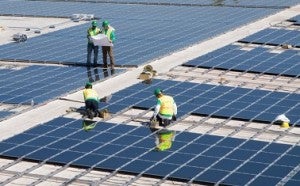 As the year draws to a close, I’m grateful for three climate breakthroughs from 2014 that give me hope that we can still turn the corner toward a stable climate before it’s too late.
As the year draws to a close, I’m grateful for three climate breakthroughs from 2014 that give me hope that we can still turn the corner toward a stable climate before it’s too late.
And I’m thankful to my colleagues at Environmental Defense Fund who crunched the numbers and determined how we can actually see global greenhouse emissions peak, level off, and begin to decline in the next five years.
EDF can’t do it alone – it will take concerted action by allies and stakeholders around the world – and it won’t be easy. But we can do it.
We know we can do this, because it’s happening already:
- Colorado pioneers pollution controls for oil, gas
The first hopeful milestone came in February, when the Colorado Air Quality Control Commission voted to adopt landmark regulations that will substantially reduce air and climate pollution from the state’s oil and gas industry.
The regulations included the first anywhere in the United States to directly control emissions of methane, a highly potent greenhouse gas that must be controlled along with carbon dioxide as part of any effective climate strategy.
The rules were endorsed by Colorado Gov. John Hickenlooper, who in 2013 asked EDF and three of the state’s largest producers; Anadarko Petroleum Corporation, Encana Corporation and Noble Energy; to develop draft recommendations.
Each year, the new rules will reduce more than 100,000 tons of methane and some 90,000 tons of smog-forming VOCs (or volatile organic compounds), equal to the same amount produced by all the cars and trucks in Colorado. They provide a model for action by other states and the federal government.
- EPA unveils plan to cut carbon from power plants
In June, the Environmental Protection Agency proposed the Clean Power Plan, which will impose the first-ever national limits on carbon pollution that can be emitted by power plants.
The plan is moderate, flexible, and above all, necessary. It sets national standards, but gives states the freedom to design an approach that fits their circumstances. It encourages investors, inventors, and entrepreneurs to find new ways to cut pollution.
And it gives industry flexibility to find the most efficient path to a clean future.
- China and U.S. make a historic announcement
The third breakthrough came in November, when China and the U.S., the world’s two largest emitters, made a historic announcement to cut global warming pollution. Now that the two countries have set new goals, the argument that the U.S. can’t act because China won’t has finally begun to fade.
A very understandable anxiety – that America can’t cut carbon emissions while our biggest competitor keeps burning dirty energy with no end in sight – can now be put to rest.
This isn’t the first time China has shown its commitment: The country already has pilot cap-and-trade markets covering nearly 250 million people, is making huge investments in solar and wind energy, and also plans to create a national carbon market.
The China-U.S. announcement is a game changer that will begin to transform the way the world thinks about climate action. Having the world’s two biggest emitters commit to reduce carbon pollution is a huge shot in the arm for global climate cooperation. Instead of nations using each other as excuses for inaction, they will challenge each other to do better.
Business trends favor climate action
But the China-U.S. climate deal is also a giant boost for clean-energy markets. Having the world’s two largest economies competing to accelerate the adoption of no-carbon and low-carbon technologies will send one of the most powerful market signals we have ever seen.
The U.S. added more solar capacity in the past two years than in the previous 30 years combined. A host of companies and even whole industries are providing the goods and services that deliver cleaner, more efficient power to consumers.
Electric vehicles and smart home thermostats are trendy.
In Nevada, Tesla is building the world’s largest advanced automotive-battery factory. In New York, Solar City is building a massive solar-photovoltaic factory.
Meanwhile, market leaders such as Google and Walmart are making huge investments in renewable energy and energy efficiency. The clean energy future is now – making it easier for nations to commit to emissions reduction.
Political trends favor climate action
We know that some elected officials still oppose climate action and publicly question climate science. But the era of denial and delay is slowly coming to an end.
Many of those same officials understand that their public stance is not just untenable, but also unwise. Now and in the years ahead, being on the right side of this issue will be a matter of political survival for both Democrats and Republicans, since 85 percent of voters under 30 support limits on carbon pollution from power plants.
These breakthroughs and trends demonstrate our capacity to tackle climate change, and they give me hope that we will be able to turn the corner toward a stable climate by 2020.
Years ago, I learned the difference between optimism and hope. As the great environmental science professor Davis Orr told me, optimism is a prediction that everything will be OK, but hope is a verb with its sleeves rolled up.
We’re prepared to roll up our sleeves, and we have an action plan for the next five years – a plan to turn the corner on global warming.
In my next blog post, I’ll share the details of that plan.
Photo source: Walmart
This post originally appeared on our EDF Voices blog.









